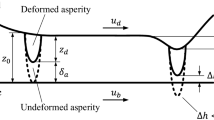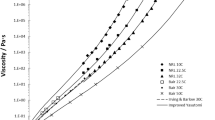Abstract
New quantitative numerical simulations of the elastohydrodynamic lubrication (EHL) film forming ability of generalized Newtonian liquids have elucidated a previously unrecognized property of EHL films. The dependency of the film thickness on the scale of the contact is greater when the viscosity is shear dependent within the inlet. Measurements of film thickness were performed in a ball on disc experiment using balls ranging from 5.5 to 35 mm in diameter. Three liquids were investigated with varying shear dependence in the range of stress important to film forming. The experimental results confirm the previous analytical findings. Numerical simulations using the measured viscosities show that the increased scale sensitivity is substantially the result of shear-thinning. However, the smallest scales produced films thinner than even the shear-dependent prediction, possibly indicating molecular degradation. It is quite likely that some machine components, which were designed using the effective viscous properties derived from a larger scale film thickness measurement, are operating with substantially lower film thickness than the designer had intended.










Similar content being viewed by others
Abbreviations
- B :
-
Doolittle parameter
- a :
-
Hertzian contact radius, m
- a V :
-
thermal expansivity, K−1
- E ′ :
-
Reduced Young’s modulus of two surfaces, Pa
- f i :
-
ith areal fraction
- F :
-
Contact load, N
- \( \hat{G} \) :
-
Dimensionless material parameter
- G i :
-
ith shear modulus, Pa
- h :
-
Film thickness, m
- h c :
-
Central film thickness, m
- K 0 :
-
Isothermal bulk modulus at p = 0, Pa
- K 00 :
-
Isothermal bulk modulus at p = 0, T = 0 K, Pa
- \( K^{\prime}_{0} \) :
-
Pressure rate of change of isothermal bulk modulus at p = 0
- M :
-
Molecular weight, kg/kmol
- N :
-
Number of flow units
- n i :
-
ith power-law exponent
- p :
-
Pressure, Pa
- p H :
-
Hertz (maximum) pressure, Pa
- R :
-
Reduced radius in the rolling direction, ball radius for a ball-on-disc geometry, m
- R m :
-
Scale of a measurement, m
- R real :
-
Scale of a machine, m
- R g :
-
Universal gas constant, =8314.34 Pa m3/kmol/K
- Δs :
-
Difference in the exponents on scale, R, shear-thinning minus Newtonian
- T :
-
Temperature, K
- T R :
-
Reference temperature, K
- \( \hat{U} \) :
-
Dimensionless speed parameter
- \( \bar{u} \) :
-
Average surface velocity or rolling velocity, m/s
- V :
-
Volume at T and p, m3
- V R :
-
Volume at reference state, T R, p = 0, m3
- V 0 :
-
Volume at p = 0, m3
- \( V_{\infty } \) :
-
Occupied volume, m3
- \( V_{{\infty {\text{R}}}} \) :
-
Occupied volume at reference state, T R, p = 0, m3
- \( \hat{W} \) :
-
Dimensionless load parameter
- x, X :
-
Coordinate in the direction of surface velocity, m, X = x/a
- y, Y :
-
Coordinate along the surface normal to the surface velocity, m, Y = y/a
- α*:
-
Reciprocal asymptotic isoviscous pressure coefficient, Pa−1
- β K :
-
Temperature coefficient of K 0, K−1
- ε :
-
Occupied volume thermal expansivity, K−1
- η:
-
Rate-dependent shear viscosity, Pa s
- μ:
-
Limiting low-shear viscosity, Pa s
- μ 0 :
-
Low-shear viscosity at p = 0, Pa s
- μ R :
-
Low-shear viscosity at reference state, T R, p = 0, Pa s
- μ r :
-
Low-shear viscosity for shear-dependent viscosity measurement, Pa s
- ρ :
-
Mass density, kg/m3
- τ :
-
Shear stress, Pa
- ϕ :
-
Film thinning parameter = h c (Newtonian)/h c (non-Newtonian)
References
Spikes, H.A.: Sixty years of EHL. Lubricat. Sci. 18, 265–291 (2006). doi:10.1002/ls.23
Dowson, D., Higginson, G.R.: Elastohydrodynamic Lubrication. Pergamon Press, Oxford (1966)
Bell, J.C., Kannel, J.W., Allen, C.M.: The rheological behavior of the lubricant in the contact zone of a rolling contact system. ASME J. Basic Eng. 86, 423–435 (1964)
Foord, C.A., Hammann, W.C., Cameron, A.: Evaluation of lubricants using optical elasto-hydrodynamics. Trans. ASLE 11, 31–43 (1968)
Liu, Y., Wang, Q.J., Wang, W., Hu, Y., Zhu, D., Krupka, I., Hartl, M.: EHL simulation using the free-volume viscosity model. Tribol. Lett. 23, 27–37 (2006). doi:10.1007/s11249-006-9101-0
Bair, S., Vergne, P., Marchetti, M.: The effect of shear-thinning on film thickness for space lubricants. STLE Tribol. Trans. 45, 330–333 (2002). doi:10.1080/10402000208982557
Liu, Y., Wang, Q.J., Bair, S., Vergne, P.: A quantitative solution for the full shear-thinning EHL point contact problem including traction. Tribol. Lett. 28, 171–181 (2007). doi:10.1007/s11249-007-9262-5
Habchi, W., Eyheramendy, D., Vergne, P., Bair, S., Morales-Espejel, G.: Thermal elastohydrodynamic lubrication of point contacts using a newtonian/generalized newtonian lubricant. Tribol. Lett. 30, 41–52 (2008). doi:10.1007/s11249-008-9310-9
Bair, S., Winer, W.O.: A simple formula for EHD film thickness of non-Newtonian liquids. In: Dowson, D., Taylor, C.M., Childs, T.H.C., Dalmaz, G., Berthier, Y., Flamand, L., Georges, J.-M., Lubrecht, A.A. (eds.) Proceedings of 23rd Leeds-Lyon Symposium EHD–96, pp. 235–241. Elsevier, Amsterdam (1997)
Kudish, I.I., Kumar, P., Khonsari, M.M., Bair, S.: Scale Effects in Generalized Newtonian Elastohydrodynamic Films. ASME J. Tribol. 130(041504), 1–8 (2008)
Krupka, I., Hartl, M., Liska, M.: Influence of contact pressure on central and minimum film thickness within ultrathin film lubricated contacts. ASME J. Tribol. 127, 890–892 (2005). doi:10.1115/1.2032991
Liu, Y., Wang, Q., Krupka, I., Hartl, M., Bair, S.: The shear-thinning elastohydrodynamic film thickness of a two-component mixture. ASME J. Tribol. 130, 021502 (2008). doi:10.1115/1.2842298
Bair, S., Qureshi, F.: The high-pressure rheology of polymer-oil solutions. Tribol. Int. 36, 637–645 (2003). doi:10.1016/S0301-679X(03)00008-2
Bair, S.: High-pressure rheology for quantitative elastohydrodynamics. Elsevier Science, Amsterdam (2007)
Casalini, R., Bair, S.: The inflection point in the pressure dependence of viscosity under high pressure: a comprehensive study of the temperature and pressure dependence of the viscosity of propylene carbonate. J. Chem. Phys. 128, 084511 (2008). doi:10.1063/1.2834203
Bair, S., Vergne, P., Querry, M.: A unified shear-thinning treatment of both film thickness and traction in EHD. Tribol. Lett. 18, 145–152 (2005). doi:10.1007/s11249-004-1770-y
Bair, S., Winer, W.O.: A quantitative test of the Einstein–Debye relation for low molecular weight liquids using the shear dependence of viscosity. Tribol. Lett. 26, 223–228 (2007). doi:10.1007/s11249-007-9195-z
Hartl, M., Krupka, I., Poliscuk, R., Liska, M.: An automatic system for real-time evaluation of EHD film thickness and shape based on the colorimetric interferometry. STLE Tribol. Trans. 42, 303–309 (1999). doi:10.1080/10402009908982221
Hartl, M., Krupka, I., Poliscuk, R., Liska, M., Molimard, J., Querry, M., Vergne, P.: Thin film colorimetric interferometry. STLE Tribol. Trans. 44, 270–276 (2001). doi:10.1080/10402000108982458
Hamrock, B.J., Dowson, D.: Isothermal elastohydrodynamic lubrication of point contacts. Part III—fully flooded results. J. Lubricat. Technol. 99, 264–276 (1977)
Blok, H.: Inverse problems in hydrodynamic lubrication and design directives for lubricated flexible surfaces. In: Muster, D., Sternlicht, B. (eds.) Proceedings International Symposium on Lubrication and Wear, Houston, Texas, pp. 7–79. McCutchan Publishing, Berkeley (1963)
Kumar, P., Khonsari, M.M.: EHL circular contact film thickness correction factors for shear thinning fluids. ASME J. Tribol. 130, 041506 (2008) doi:10.1115/1.2959115
Venner, C.H., Bos, J.: Effects of lubricant compressibility on the film thickness in EHL line and circular contacts. Wear 173, 151–165 (1994). doi:10.1016/0043-1648(94)90268-2
Bair, S., Qureshi, F., Kotzalas, M.: The low shear stress rheology of a traction fluid and the influence on film thickness. Proc. Inst. Mech. Eng. 218, 95–98 (2004)
LaFountain, A.R.: The behaviour of lubricant blends in elastohydrodynamic contacts, Ph.D. thesis, Imperial College of Science, Technology and Medicine, London (1999)
Acknowledgments
Film thickness measurements were carried out with the support of the Ministry of Education, Youth and Sports of the Czech Republic—Project No. ME905. Bair was supported by the National Science Foundation under grant number EEC#0540834.
Author information
Authors and Affiliations
Corresponding author
Appendix
Appendix
The classical Hamrock and Dowson [20] equation for central film thickness in a circular contact is given in terms of three dimensionless parameters as
where the dimensionless parameters are
The only parameters available within this formula (10) for the description of the behavior of the liquid are the ambient viscosity, μ 0, and the pressure–viscosity coefficient, α*. There are no parameters which quantify either the compressibility of the liquid or the shear dependent viscosity. The dimensionless parameters are given in Table 4 for these experiments.
Compressibility directly affects the central film thickness by the compression of the liquid volume to the Hertz pressure [23]. Compressibility varies somewhat with composition and increases exponentially with temperature. At least one additional parameter, say K 0, would be necessary to arrive at a film thickness formula which includes the effect of variable compressibility.
In this work, it is seen that shear dependent viscosity plays an important role in film formation when the Newtonian limit, G, is sufficiently low that shear thinning occurs in the inlet. To include the effect of shear-thinning would require at least two additional parameters, G and n, in a film thickness formula.
In practice, variations in compressibility and shear dependent viscosity are accommodated in Eq. 10 by treating the pressure–viscosity coefficient, α*, as an effective parameter, obtained from a film thickness measurement, rather than from the definition of Eq. 9. This work examines only the effect of shear-thinning on extrapolations to different scale, R, using the effective pressure–viscosity coefficient.
In terms of only the load and scale, Eq. 10 shows that the film thickness varies as
for a Newtonian liquid of slight compressibility. A measurement of film thickness for extrapolation to a real machine would more sensibly simulate the pressure, p H, than the load of the machine component. Therefore, the relation between pressure and load, \( F \propto p_{\text{H}}^{3} R^{2} \), can be employed to recast (12) as
for a Newtonian liquid of slight compressibility. The complete form of (13) is given in (8). The contact pressure is not varied in this work and variations in compressibility will therefore not affect the results.
Inspection of Eq. 8 shows that the classical Hamrock and Dowson formula predicts that the speed sensitivity, \( d(\log h_{\text{c}} )/d(\log \bar{u}) \), should be equal to 0.67. Unless the inlet rheology is operating within one of the Newtonian plateaus, a shear-thinning liquid should have speed sensitivity <0.67. Therefore, it would be inappropriate to extrapolate from the classical formula to smaller scales from a large scale measurement which displayed a speed sensitivity of measurably <0.67. In practice, however, this restriction has been difficult to implement. The large scale measurements presented here have speed sensitivities indistinguishable from Newtonian. Polymer blended liquids can display the Newtonian sensitivity to speed while having significant film thinning [24] because of the plateaus. Base oils can display film thinning, as does the PAO100 investigated in [12]. Another PAO100 was investigated at Imperial College [25] where among ten low molecular weight base oils for which the inlet behavior should be Newtonian the speed sensitivities at various temperatures ranged from 0.64 to 0.74. The PAO100 at various temperatures yielded speed sensitivities from 0.62 to 0.65. It would be difficult to assess the shear thinning behavior of the PAO100 from the speed sensitivity alone in this case and effective pressure–viscosity coefficients were reported. Of course, for low values of both G and n, the speed sensitivity will obviously betray the shear-thinning response.
Rights and permissions
About this article
Cite this article
Krupka, I., Bair, S., Kumar, P. et al. An Experimental Validation of the Recently Discovered Scale Effect in Generalized Newtonian EHL. Tribol Lett 33, 127–135 (2009). https://doi.org/10.1007/s11249-008-9397-z
Received:
Accepted:
Published:
Issue Date:
DOI: https://doi.org/10.1007/s11249-008-9397-z




